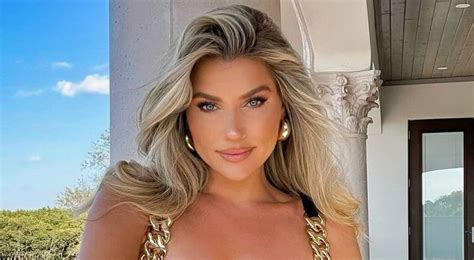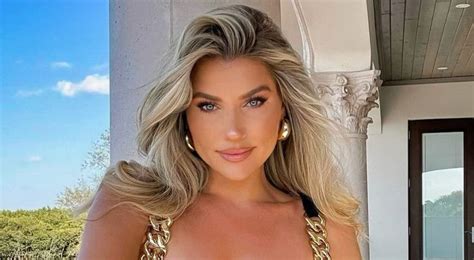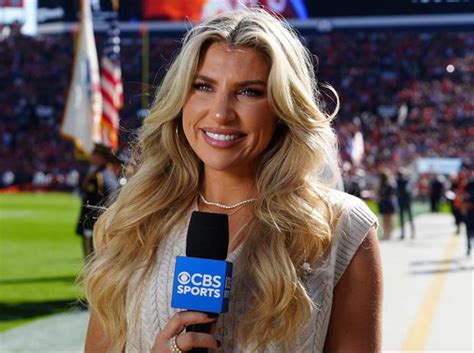
Melanie Collins, CBS Sports sideline reporter, sparked a significant online buzz with her recent sideline appearance, drawing widespread attention and praise for her fashion choices. Fans have taken to social media to express their admiration for her “stunning” and “chic” game-day attire, transforming what might be routine coverage into a trending topic.
The enthusiastic reactions highlight the growing intersection of sports and fashion, and the increasing interest in the personal style of on-air personalities. Collins, known for her insightful reporting and engaging on-screen presence, has now also gained recognition for her sartorial selections, further solidifying her position as a prominent figure in sports broadcasting. Her ability to blend professionalism with contemporary style has resonated with a broad audience, demonstrating the power of fashion in enhancing a public figure’s appeal and influence.
The attention surrounding Collins’ style underscores a broader trend in sports media, where sideline reporters and commentators are increasingly viewed as style icons. This phenomenon reflects a shift in audience expectations, with viewers now paying closer attention to the overall presentation and image of on-air talent. Collins’ case exemplifies how fashion choices can contribute to a reporter’s brand and influence, turning routine sideline reporting into a platform for personal expression and style inspiration. The positive reception to her attire also suggests a growing appreciation for fashion-forward personalities within the sports broadcasting industry, indicating that style is becoming an increasingly important aspect of a reporter’s public persona.
The positive reactions on social media platforms, from X (formerly Twitter) to Instagram, showcased comments praising Collins’ outfit choices, her overall look, and even requests for details on where to purchase similar items. This level of engagement suggests that Collins’ influence extends beyond her reporting skills, positioning her as a style influencer within the sports community.
Fans are not just admiring Collins’ fashion sense; they are actively engaging with it, seeking inspiration for their own wardrobes and expressing admiration for her ability to seamlessly blend high fashion with practical sideline attire. This phenomenon underscores the growing role of sideline reporters as fashion trendsetters and style icons, reflecting a broader trend in media where personality and presentation are increasingly valued alongside expertise and knowledge. Collins’ ability to generate such a strong reaction through her fashion choices highlights the power of personal style in shaping public perception and solidifying a prominent position within the sports broadcasting industry. The blending of her professional role with her fashion sense exemplifies how modern media personalities are able to connect with audiences on multiple levels, enhancing their overall appeal and influence.
The specific outfit that garnered so much attention featured a sophisticated and contemporary design, reflecting current fashion trends while remaining appropriate for a professional sports environment. The choice of colors, fit, and accessories all contributed to a polished and stylish appearance that resonated with viewers. The outfit projected confidence and professionalism, enhancing Collins’ credibility as a reporter while also showcasing her personal style and fashion-forward sensibilities. This careful balance between appropriateness and individuality is a key element of Collins’ appeal, demonstrating her ability to navigate the demands of her profession while remaining true to her personal aesthetic.
The focus on Collins’ fashion choices highlights the broader trend of increased scrutiny on the appearance of public figures, particularly women in media. However, the overwhelmingly positive reaction suggests a shift towards celebrating personal style and individuality, rather than imposing restrictive standards of dress. Fans are praising Collins not only for her fashion sense but also for her confidence and poise, indicating that they appreciate her ability to express herself through her clothing choices while maintaining a professional demeanor.
This positive reception to Collins’ style choices stands in contrast to the often critical and judgmental commentary directed towards women in the public eye, demonstrating a growing appreciation for diversity and individuality. The focus on her attire has also opened up a broader conversation about the role of fashion in sports media, with many viewers recognizing the importance of personal style in enhancing a reporter’s presence and appeal. This shift towards celebrating individuality and personal expression reflects a broader cultural trend towards greater acceptance and inclusivity, challenging traditional notions of professionalism and appearance.
The social media commentary included remarks about the specific brands and designers Collins might be wearing, as well as requests for her to share details about her styling choices. This level of engagement indicates that fans are not just passively admiring her fashion sense; they are actively seeking to emulate it, positioning Collins as a style influencer within the sports community. The attention on her clothing and accessories suggests that viewers are interested in the details of her outfits, from the cut and fabric of her garments to the specific brands and designers she favors. This level of interest underscores the power of fashion in shaping public perception and influencing consumer behavior, demonstrating how Collins’ style choices can inspire and motivate her fans.
The attention on Collins’ fashion extends beyond mere admiration, as fans actively seek to incorporate her style into their own wardrobes. This level of engagement underscores the power of personal style in shaping public perception and influencing consumer behavior, demonstrating how Collins’ fashion choices can inspire and motivate her fans. By showcasing her unique sense of style, Collins has not only enhanced her public image but also created a platform for personal expression and connection with her audience. The interest in her fashion choices reflects a broader trend in media, where personality and presentation are increasingly valued alongside expertise and knowledge, allowing reporters to connect with viewers on multiple levels.
In addition to the positive reception from fans, Collins’ style choices have also garnered attention from fashion industry observers and commentators. Many have praised her ability to seamlessly blend high fashion with the practical demands of sideline reporting, noting her talent for creating polished and stylish looks that are both appropriate and expressive. This recognition from fashion industry professionals further solidifies Collins’ position as a style icon within the sports community, demonstrating her ability to command attention and admiration both on and off the field. The attention from fashion commentators also underscores the growing intersection of sports and fashion, reflecting a broader trend in media where personal style is increasingly valued as a form of self-expression and communication.
The attention surrounding Melanie Collins’ sideline style underscores the growing importance of fashion in sports media. As viewers become more attuned to the personal style of on-air personalities, reporters like Collins are finding new ways to connect with their audience and enhance their overall appeal. By embracing her unique fashion sense, Collins has not only garnered attention for her reporting skills but also established herself as a style influencer within the sports community, demonstrating the power of personal expression in shaping public perception.
The positive reception to her fashion choices serves as a reminder that style can be a powerful tool for self-expression and communication, allowing individuals to connect with others on a deeper level. As sports media continues to evolve, it is likely that fashion will play an increasingly important role in shaping the public image of on-air personalities, allowing them to showcase their individuality and connect with their audience in new and meaningful ways.
In-depth Analysis:
Melanie Collins’ recent fashion spotlight is indicative of several evolving trends within the media landscape and broader cultural attitudes towards public figures, especially women. It moves beyond simple aesthetic appreciation and touches upon themes of empowerment, influence, and the changing definition of professionalism.
1. The Blurring Lines of Professionalism and Personal Expression:
Historically, sideline reporters, especially in male-dominated fields like the NFL, were primarily judged on their knowledge of the game, interviewing skills, and ability to deliver accurate and timely information. Personal style was often considered secondary, and there was a tendency to favor conservative or neutral attire that wouldn’t distract from the sporting event itself.
Collins’ experience suggests a shift away from this rigid expectation. While her reporting acumen remains paramount, her fashion choices have become a subject of discussion and admiration. This indicates a growing acceptance, and even celebration, of personal style within a professional context. It suggests that audiences are increasingly comfortable with seeing reporters express their individuality through fashion, as long as it doesn’t compromise their credibility or detract from the event.
This blurring of lines can be attributed to several factors:
- The Rise of Social Media: Platforms like Instagram and X have made it easier for public figures to connect with their audiences on a more personal level, sharing glimpses into their lives and showcasing their individual styles.
- The Democratization of Fashion: Fashion is no longer seen as the exclusive domain of high-end designers and elite circles. Social media influencers and online retailers have made it more accessible and democratic, allowing individuals to experiment with different styles and express themselves creatively.
- Changing Cultural Norms: Society is becoming more accepting of individuality and self-expression, challenging traditional notions of what constitutes “professional” behavior.
2. Female Empowerment and Challenging Traditional Norms:
The overwhelmingly positive reaction to Collins’ style choices can be interpreted as a form of female empowerment. For years, women in the public eye have faced intense scrutiny over their appearance, often being judged more harshly than their male counterparts.
By celebrating Collins’ fashion sense, fans are pushing back against these double standards and acknowledging her right to express herself through her clothing choices. They are also recognizing that a woman can be both intelligent and stylish, competent and fashionable.
This support sends a powerful message that women should be celebrated for their individuality and not confined to narrow definitions of professionalism. It also encourages women to embrace their personal style and express themselves confidently, regardless of societal expectations.
3. Sideline Reporters as Style Influencers:
Collins’ case highlights the growing trend of sideline reporters becoming style influencers. With their high visibility and frequent on-screen appearances, these reporters have a significant platform to showcase their personal style and influence the fashion choices of their audience.
This trend has several implications:
- Increased Brand Partnerships: Sideline reporters may increasingly collaborate with fashion brands, endorsing their products and promoting their collections.
- Growing Demand for Fashion Commentary: Sports media outlets may begin to incorporate more fashion-related content into their coverage, analyzing the style choices of reporters and athletes.
- Shift in Audience Expectations: Viewers may start to expect sideline reporters to be not only knowledgeable about sports but also stylish and well-dressed.
4. The Commercial Impact of Fashion Choices:
The social media commentary requesting details about Collins’ clothing and accessories underscores the commercial impact of her fashion choices. Her outfit selections can drive sales and influence consumer behavior, making her a valuable asset for fashion brands.
This commercial potential highlights the intersection of sports, fashion, and marketing. Companies are increasingly recognizing the power of sports figures and media personalities to influence consumer behavior, leading to more collaborations and endorsements.
5. Potential Pitfalls and Ethical Considerations:
While the attention surrounding Collins’ style is largely positive, it also raises some potential pitfalls and ethical considerations.
- Objectification: There is a risk that focusing too much on a reporter’s appearance could lead to objectification and undermine her credibility.
- Pressure to Conform: Reporters may feel pressured to conform to certain fashion trends or standards, which could stifle their individuality.
- Conflict of Interest: Brand partnerships could create conflicts of interest if reporters are seen as promoting products or brands during their on-air appearances.
It is important to strike a balance between celebrating personal style and maintaining professional integrity. Media outlets and reporters should be mindful of these potential pitfalls and ensure that fashion choices do not overshadow the primary purpose of sports reporting.
Background Information:
Melanie Collins is a well-established sports broadcaster, known for her work with CBS Sports, covering NFL games and other major sporting events. Her career has spanned multiple networks and roles, including sideline reporting, hosting, and studio analysis. She has built a reputation for her sharp insights, engaging personality, and professional demeanor.
The phenomenon of sideline reporters gaining attention for their style is not entirely new. Other prominent female sports broadcasters, such as Erin Andrews and Charissa Thompson, have also been recognized for their fashion choices. However, the scale and intensity of the reaction to Collins’ recent appearance suggest a growing trend and a heightened level of audience engagement with the personal style of on-air personalities.
Expanded Context:
The intersection of sports and fashion has been gaining momentum in recent years, with athletes increasingly viewed as style icons and fashion brands sponsoring sporting events and teams. This trend reflects a broader cultural shift towards a more holistic view of athletes and sports figures, recognizing their influence beyond the field of play.
The attention on Collins’ style can also be seen as part of a larger movement towards greater representation and diversity in sports media. As more women take on prominent roles in sports broadcasting, they are challenging traditional norms and bringing fresh perspectives to the industry. Their presence not only enhances the quality of coverage but also inspires young women to pursue careers in sports media.
Conclusion:
Melanie Collins’ experience highlights the evolving dynamics of sports media and the growing importance of personal style in shaping public perception. Her ability to generate such a strong reaction through her fashion choices demonstrates the power of self-expression and the increasing acceptance of individuality within a professional context.
As the media landscape continues to evolve, it is likely that fashion will play an increasingly important role in shaping the public image of on-air personalities. By embracing their unique styles and connecting with their audience on a more personal level, reporters like Collins can enhance their influence and contribute to a more diverse and engaging sports media landscape. However, it is important to be mindful of the potential pitfalls and ethical considerations, ensuring that fashion choices do not overshadow the primary purpose of sports reporting.
Frequently Asked Questions (FAQ):
Q1: What specifically sparked the attention surrounding Melanie Collins’ sideline style?
A1: The specific outfit Collins wore during a recent NFL game broadcast on CBS Sports generated significant buzz on social media. While the exact details of the outfit aren’t explicitly described in the article, its overall sophistication, contemporary design, and suitability for a professional sports environment were praised. Fans and fashion industry observers alike commented on her chic and polished appearance, leading to widespread admiration and discussion.
Q2: Is this the first time a sports reporter has received attention for their fashion sense?
A2: No, this is not the first time a sports reporter has garnered attention for their fashion choices. Prominent female sports broadcasters such as Erin Andrews and Charissa Thompson have also been recognized for their style in the past. However, the intensity and scale of the reaction to Melanie Collins’ recent appearance suggests a growing trend and a heightened level of audience engagement with the personal style of on-air personalities. It reflects an increasing interest in the overall presentation and image of reporters, alongside their reporting skills and knowledge of the game.
Q3: How has social media played a role in the attention Melanie Collins has received?
A3: Social media has played a crucial role in amplifying the attention surrounding Melanie Collins’ style. Platforms like X (formerly Twitter) and Instagram provided a space for fans to express their admiration, share comments about her outfits, and even inquire about specific brands and designers. This widespread online discussion transformed what might have been a routine sideline appearance into a trending topic, showcasing the power of social media to shape public perception and influence fashion trends. Social media also allows direct interaction and influence, further fueling the discussions.
Q4: What are some potential implications of sports reporters being seen as style influencers?
A4: The trend of sports reporters becoming style influencers has several potential implications. Firstly, it could lead to increased brand partnerships and endorsements, as fashion companies seek to capitalize on their influence. Secondly, sports media outlets might incorporate more fashion-related content into their coverage, analyzing the style choices of reporters and athletes. Thirdly, it could shift audience expectations, with viewers increasingly expecting sideline reporters to be not only knowledgeable about sports but also stylish and well-dressed. Finally, it may put added pressure on reporters to conform to certain fashion trends or standards, which could stifle their individuality.
Q5: Are there any potential negative consequences associated with the focus on a reporter’s appearance?
A5: Yes, there are potential negative consequences associated with the focus on a reporter’s appearance. One risk is objectification, where excessive attention to appearance could undermine a reporter’s credibility and detract from their reporting skills. Another concern is the pressure to conform, which could force reporters to adhere to certain fashion trends or standards, limiting their individuality. Additionally, brand partnerships could create conflicts of interest if reporters are seen as promoting products or brands during their on-air appearances. It is crucial to strike a balance between celebrating personal style and maintaining professional integrity to avoid these negative consequences.









